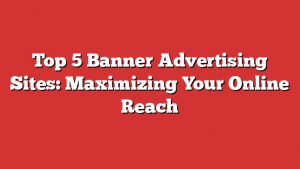In a digital landscape teeming with possibilities, the power of banneradvertising cannot be underestimated.
With countless brands vying for attention, it’s crucial to know where to invest your advertising dollars wisely.
In this article, we unveil the top 10 banneradvertising sites that hold the keys to reaching a vast audience and maximizing your marketing efforts.
Whether you’re a small business owner or a seasoned marketer, this is a must-read to stay ahead of the game.
Table of Contents
Banner advertising sites are online platforms that allow businesses to display their advertisements in the form of banners on various websites and social media channels.
These sites provide a way for companies to reach a wider audience and increase their brand visibility.
The top 10 banner advertising sites include Facebook Advertising Banner Ads, Google Display Network, YouTube Advertising, Bing Ads, Twitter Advertising, LinkedIn Advertising, Pinterest Advertising, Instagram Advertising, Amazon Advertising, and Snapchat Advertising.
These platforms offer different targeting options and reach millions of users, making them effective tools for businesses to promote their products or services.Key Points:
- Banner advertising sites display advertisements in the form of banners on websites and social media channels
- They help businesses expand their reach and increase brand visibility
- The top 10 banner advertising sites include:
- YouTube
- Bing
- Amazon
- Snapchat
- These platforms offer various targeting options and reach millions of users
- Businesses use these sites to promote products or services
- Banner advertising sites are effective tools for online advertising
Check this out:
💡 Did You Know?
1. Banner ads were first introduced in 1994 on HotWired.com, the first commercial web magazine, which is now known as Wired.com.
2. The first-ever online banner ad had a click-through rate of 78%, much higher than the average click-through rate today, which is around 0.1%.
3. The world’s first banner ad was for AT&T, and it simply read, “Have you ever clicked your mouse right here? You will.” – a pioneering call to action.
4. The term “banner blindness” was coined in 1998 to describe the phenomenon of users consciously or subconsciously ignoring banner ads due to their overexposure and often intrusive nature.
5. The standard size for a banner ad, known as a “leaderboard,” is 728 pixels wide by 90 pixels tall, and it was established by the Interactive Advertising Bureau (IAB) in 1996.
1. Facebook Advertising
Facebook Advertising is one of the most widely used and effective banner advertising platforms available today. With over 2.8 billion monthly active users, Facebook offers unparalleled reach for businesses looking to connect with their target audience. The platform allows advertisers to create visually captivating banner ads that can be targeted based on various demographic, geographic, and interest-based criteria.
In addition to precise targeting options, Facebook also provides robust analytics and reporting tools, allowing advertisers to track the performance of their banner ads and optimize their campaigns for maximum effectiveness. With features like custom audiences and lookalike audiences, businesses can leverage their existing customer data to reach new potential customers and expand their online presence.
Furthermore, Facebook’s ad platform offers various placement options for banner ads, including the desktop newsfeed, mobile newsfeed, and the right-hand column. This flexibility allows advertisers to tailor their campaigns to specific devices and maximize their ad visibility. With such comprehensive targeting and placement options, it’s no wonder Facebook Advertising is considered a top banner advertising site for businesses of all sizes.
2. Google Display Network
As part of the larger Google Ads ecosystem, the Google Display Network (GDN) offers an extensive reach for businesses looking to display their banner ads on high-traffic websites and apps. With over two million participating websites and the ability to reach over 90% of internet users worldwide, the GDN provides unparalleled exposure for advertisers.
One of the key benefits of the GDN is its advanced targeting capabilities. Advertisers can target their banner ads based on keywords, demographics, interests, and even specific websites. This level of precision ensures that ads are shown to the right audience at the right time, increasing the chances of generating engagement and conversions.
Additionally, the GDN offers a range of ad formats, including responsive ads, animated ads, and HTML5 ads. This flexibility allows businesses to create visually compelling and interactive banner ads that capture the attention of users.
With the ability to track conversions and optimize campaigns in real-time, the Google Display Network is a powerful tool for maximizing online reach and driving business growth.
Bullet Points:
- Unparalleled reach with over two million participating websites
- Advanced targeting options based on keywords, demographics, interests, and specific websites
- Various ad formats including responsive ads, animated ads, and HTML5 ads
- Real-time tracking and campaign optimization for maximum results and growth
3. YouTube Advertising
YouTube is the world’s second-largest search engine and a valuable platform for businesses to showcase their products and services through banner advertising. With over two billion logged-in monthly users, YouTube offers an extensive audience reach and diverse targeting options, making it a top banner advertising site.
Updated for 2025’s advertising best practices.
One of the key advantages of YouTube advertising is the ability to target specific video content or channels. Businesses can display their banner ads before, during, or after relevant videos, ensuring that their message reaches users who are interested in related topics. This targeting capability allows advertisers to reach users with high purchase intent, increasing the chances of driving conversions.
Furthermore, YouTube offers various ad formats, such as skippable ads, non-skippable ads, and overlay ads. This diversity allows businesses to create engaging and visually appealing banner ads that align with their branding and resonate with their target audience. Combined with the ability to measure ad performance and optimize campaigns, YouTube advertising proves to be an effective way to maximize online reach and increase brand visibility.
4. Bing Ads
While Bing may not have the same market dominance as Google, Bing Ads should not be overlooked when it comes to banner advertising. Bing Ads allows businesses to display their banner ads on the Bing search engine and its partner sites, reaching millions of users who prefer Bing as their search engine of choice.
One of the benefits of Bing Ads is the ability to import campaigns directly from Google Ads. This streamlined process saves businesses time and effort when setting up their banner ad campaigns. Additionally, Bing Ads offers unique targeting options, such as the ability to target specific age groups, gender, and income brackets. This precision targeting can be particularly advantageous for businesses that have defined target demographics.
Moreover, Bing Ads provides robust reporting and analytics tools that allow businesses to track the performance of their banner ads. Advertisers can access data on impressions, clicks, and conversions, enabling them to make informed decisions and optimize their campaigns for better results. With its distinct audience reach and targeting options, Bing Ads is a valuable banner advertising site to consider for maximizing online reach.
5. Twitter Advertising
Twitter Advertising is a powerful platform for businesses looking to reach and engage with their target audience through banner ads. With over 330 million daily active users, Twitter offers a significant user base that can be segmented based on interests, demographics, and behaviors.
One of the key features of Twitter Advertising is the ability to promote tweets as banner ads. This means businesses can turn their top-performing tweets into visually striking banner ads that seamlessly blend with users’ feeds. This native advertising approach ensures that ads appear in a non-intrusive manner and provides a higher chance of capturing users’ attention.
Additionally, Twitter offers various targeting options, such as keyword targeting, follower targeting, and interest targeting. This level of granularity allows businesses to refine their target audience and deliver their banner ads to users who are most likely to be interested in their products or services. Furthermore, advertisers can also leverage Twitter’s real-time conversation insights to identify trending topics and engage with users effectively.
With its engaged user base and advanced targeting capabilities, Twitter Advertising proves to be a valuable banner advertising site for businesses looking to maximize their online reach and drive engagement.
Conclusion
In conclusion, these top 5 banner advertising sites present valuable opportunities for businesses to maximize their online reach. Whether it’s leveraging the vast reach of Facebook Advertising, harnessing the precise targeting capabilities of the Google Display Network, capitalizing on the engaged user base of YouTube Advertising, tapping into the unique audience of Bing Ads, or engaging with users on Twitter Advertising, businesses have a range of options to effectively promote their products and services through banner ads.
By strategically selecting and utilizing these banner advertising platforms, businesses can boost their brand visibility, drive engagement, and ultimately increase their online reach. It’s essential for businesses to continually monitor and optimize their banner ad campaigns using the comprehensive analytics and reporting tools provided by these platforms.
In today’s digital landscape, banner advertising is a powerful tool for businesses to connect with their target audience and achieve their marketing objectives. With the right approach and a deep understanding of these top banner advertising sites, businesses can successfully expand their online presence and drive business growth.
FAQ
Banner ads can be strategically placed on the front, bottom, or side of a webpage to capture the attention of browsing users. Placing them on the front of a webpage ensures maximum visibility, as it is the first thing users see upon visiting the site. The bottom of a webpage is also a good location as users’ eyes tend to naturally wander there, increasing the chances of engagement. Additionally, the side of a webpage can be another effective placement option as it allows for continuous visibility while users scroll through the content, maximizing the potential for click-throughs and brand awareness.
A banner ad is a rectangular advertisement displayed on a website, strategically placed at the top, side, or bottom of the page. Its purpose is to attract viewers’ attention and redirect them to the advertiser’s website, with the aim of increasing traffic, raising awareness about a brand, and promoting overall brand consideration. This visual display ad is employed as an effective form of online advertising.
While the 320×50 banner is undeniably popular, another banner ad format that is gaining traction is the Native Banner. This ad seamlessly blends into the design of the mobile app or website, offering a less intrusive and more engaging advertising experience. Studies have shown that Native Banners have higher click-through rates and generate better user engagement, making them a top choice for advertisers looking to maximize their reach in 2023. Incorporating both the Mobile Leaderboard and Native Banner formats in your inventory can provide a well-rounded and effective advertising strategy for the future.
The earnings from banner ads on websites can vary depending on factors such as the number of ad impressions and the commission taken by the network. On average, site owners can expect to earn around $5 per 1,000 ad impressions. Taking into account the commission of 20-30%, aiming for a cost of around 0.3 cents per impression or a CPM of $3 is recommended. So, if your website receives approximately 100,000 visits per month, you can potentially earn around $300 per ad.












